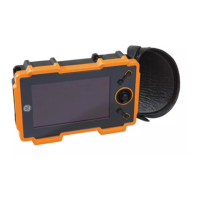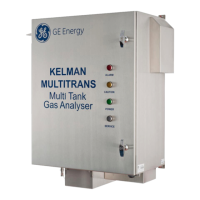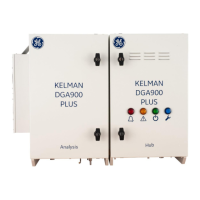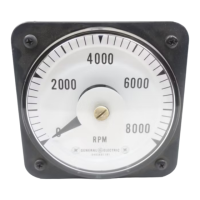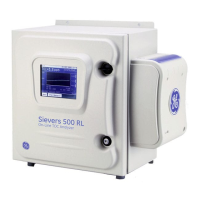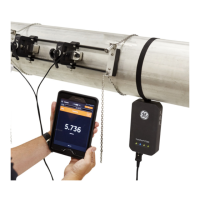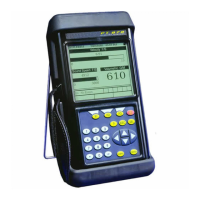Krautkramer USM 35X Issue 01, 04/2005 5-63
OperationDistance-amplitude curve (only USM 35X DAC and USM 35S)
DACECHO (Recording reference curve)
A Attention:
Before starting to record a reference curve, the instru-
ment must be correctly calibrated (ref. section
5.7
Calibrating the USM 35X
).
The moment a new curve is recorded, a possibly al-
ready existing curve must be deleted. If necessary,
make sure that the old curve has been stored in a free
data set before starting to record a new curve!
– Select the function DACMOD.
– Use the right-hand rotary knob to set the function to
DAC. The function DACECHO is set to 0 since there
is no previously recorded echo.
– Couple the probe to the reference block, and peak
the first reference echo. Use the left-hand rotary knob
to bring the echo to an amplitude between 70 % and
100 % screen height.
– Select the function aSTART, and then move the gate
so that the selected echo is the highest of the echo
sequence within the gate range.
– Press
to record the first reference echo. The
instrument gain will automatically change until the
DAC echo in gate A reaches 80% screen height
(+/–0,3 dB). The function DACECHO is set to 1 to
indicate that the first reference echo has been
successfully recorded. Simultaneously the status
symbol “R” appears (= reference echo stored).
– Peak the next reference echo, and repeat the record-
ing process for other curve points. The number in the
function DACECHO is increased by 1 with each
recording.
H Note:
If the message “Echo is not valid” appears, the refer-
ence point could not be recorded. Check the gate posi-
tion as well as the height of the reference echo and
repeat the recording.
As soon as you have recorded at least two curve refer-
ence points. Your DAC is already active (please see
previous section). You can record a maximum of
10 curve reference points.
Krautkramer USM 35X Issue 01, 04/2005 5-63
OperationDistance-amplitude curve (only USM 35X DAC and USM 35S)
DACECHO (Recording reference curve)
A Attention:
Before starting to record a reference curve, the instru-
ment must be correctly calibrated (ref. section
5.7
Calibrating the USM 35X
).
The moment a new curve is recorded, a possibly al-
ready existing curve must be deleted. If necessary,
make sure that the old curve has been stored in a free
data set before starting to record a new curve!
– Select the function DACMOD.
– Use the right-hand rotary knob to set the function to
DAC. The function DACECHO is set to 0 since there
is no previously recorded echo.
– Couple the probe to the reference block, and peak
the first reference echo. Use the left-hand rotary knob
to bring the echo to an amplitude between 70 % and
100 % screen height.
– Select the function aSTART, and then move the gate
so that the selected echo is the highest of the echo
sequence within the gate range.
– Press
to record the first reference echo. The
instrument gain will automatically change until the
DAC echo in gate A reaches 80% screen height
(+/–0,3 dB). The function DACECHO is set to 1 to
indicate that the first reference echo has been
successfully recorded. Simultaneously the status
symbol “R” appears (= reference echo stored).
– Peak the next reference echo, and repeat the record-
ing process for other curve points. The number in the
function DACECHO is increased by 1 with each
recording.
H Note:
If the message “Echo is not valid” appears, the refer-
ence point could not be recorded. Check the gate posi-
tion as well as the height of the reference echo and
repeat the recording.
As soon as you have recorded at least two curve refer-
ence points. Your DAC is already active (please see
previous section). You can record a maximum of
10 curve reference points.
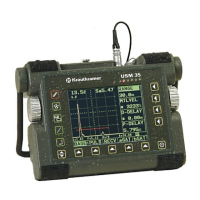
